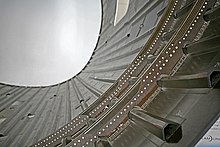Stringer (traffic engineering)

Riveted aluminum stringers on a section of the fuselage of a Boeing 747
Stringers are longitudinal stiffeners that increase the rigidity of large, flat components and prevent them from bulging. They are used in shipbuilding as well as in lightweight construction for aircraft , but also in rocket construction. In shipbuilding, the term Weger is more common, but these have no direct contact with the outer skin, but lie on the inside of the ribs , while longitudinal stiffeners with a thicker cross-section are referred to as longitudinal ribs .
Together with the frames , stringers form the supporting frame of an aircraft, the stringers running at right angles to the frames and thus mostly parallel to the longitudinal axis of the component.
See also : support bracket
development
- At the beginning there is the construction principle keel and frames , in which a keel is laid first, then the frames are attached at right angles and the planking is attached last. In this way, spatial constructions are possible whose size (in contrast to the dugout ) exceeds that of the largest individual part. They can be easily constructed on the drawing board by breaking them down into two-dimensional sections .
- With the division of forces into tension and pressure absorbing structural elements, the construction principle of ribs and spars emerged , as it is still relevant today in aircraft construction. Aircraft must be rigid in every plane; a single keel is too heavy and not stable enough in its transverse plane. A construction frame is necessary for the production of such objects, a kind of "keel that can be removed", which is removed from the construction as soon as it has sufficient inherent stability .
- If finer and finer bars are added to the construction to promote stability and the cross-section of the bars is reduced, you get to bars, stringers and frames and finally the stringer and frames , a preliminary stage to the self-supporting outer skin . A high torsional stiffness cannot be achieved in this way, however, since 90 ° angles are still present.
- The next higher developed construction method is the geodetic construction method. Frames are largely dispensed with here; the structural and load-bearing construction elements are rhombuses and triangles, formed by band-shaped stringers that run helically around the object. For this it is necessary to first construct the planned hull shape in conventional cross-sections, and then to calculate a spiral development . The fuselage can finally be formed by riveting the straps at the calculated knot distances. The British bomber Vickers Wellington is an example of this. The mesh size is variable, depending on how much load has to be absorbed and how precisely the contours have to be formed. Such a construction is not feasible for submarines , as ring frames are much more stable.
- Thanks to modern composite materials, the self-supporting outer skin has become conceivable today; however, it is very expensive because a lot of effort is required to be economical. Such outer skins can be laminated using rigid foam cores, but production is complex and repairs are difficult. The effort is only worthwhile with individual pieces.
- Current constructions of aircraft, submarines, bridges or roofs usually combine stringers, frames, geodetic construction and self-supporting outer skin. This has made it possible to achieve a high level of economy, but the construction process requires computer-aided design . This construction method is also seen as a bionic principle , because after the external shape has been determined, various implementation options compete in the static, economic and aesthetic disciplines until it becomes clear which construction method is best suited for which detail. Then the interlinking of individual methods is examined with regard to durability and feasibility and examined again economically. It may well be that a detail could be realized very well according to a special concept, but it would be too time-consuming to include an additional construction principle in the concept only for this detail, another would be uneconomical in detail, but economically as a whole.
literature
- Author collective: Stahlschiffbau . transpress Verlag, Berlin 1989, ISBN 3-341-00410-6 .
